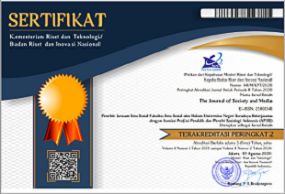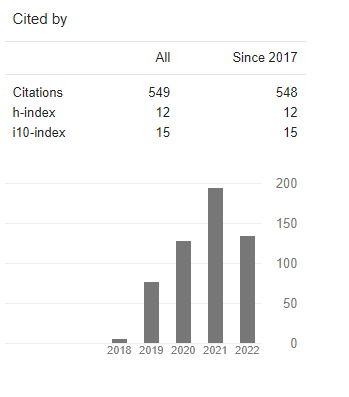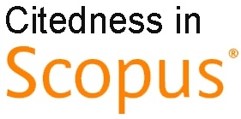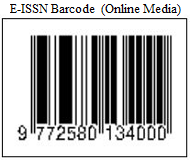Diabetes Disease in Geoff Marsh Film Documentary, Implication for Sub-Sahara Africa and the International Community
DOI:
https://doi.org/10.26740/jsm.v9n1.p159-173Keywords:
agenda, awareness creation, diabetes, film documentary, sub-sahara africaAbstract
The global burden of non-communicable diseases is increasing daily. Non-communicable diseases like hypertension, cancer, and diabetes have caused the death of more people in 21st-century sub-Saharan Africa than it has ever done. Also, the world celebrates 100 years of insulin, however, many, children and people in the Sub-Sahara with type 1 and type 2 diabetes die for lack of access to insulin or diabetes medications. Worse yet, the present status of diabetes in Sub-Saharan Africa is not well-known. The article uses content analysis and agenda-setting theory to examine Geoff Marsh's documentary on diabetes in Sub-Saharan Africa.. The documentary was produced with the support of AstraZeneca, Medtronic, and copyrighted by Springer Nature LTD 2021 (the video was downloaded from YouTube). The analysis of the documentary linked the death toll resulting from diabetes to a change in lifestyle and the government's meagre budget for the health sector in Sub- Saharan Africa. Filmmakers in the Sub-Saharan region should advocate and prioritize the maintenance of a healthy personal diet, engage in regular physical exercise, and maintain a normal body weight in their films. Sponsored radio and television programs focusing on managing and preventing the disease are needed across countries in the sub-Sahara
References
Bala, M.D., and S. Halima. 2020. "Agenda Setting and Framing Theories: A Methodological Review of Selected Empirical Studies." MCC 4(1):35–54.
Blessing, A. 2022. "Media Usage, Media Violence and the Nigerian Child." Language, Discourse & Society 10(1):1–13.
Chen, L., J.H. Pei, J. Kuang, et al. 2015. "Effect of Lifestyle Intervention in Patients with Type 2 Diabetes: A Meta-analysis." Metabolism 64:338–347.
Chinaza, G.A., K.E. Chinelo, and S.I. Victory. 2020. "Diabetes and Nutrition and Diets for Its Prevention and Treatment: A Systematic Review and Dietetic Perspective." Health Sciences Research 6(1):5–19.
Cook, A.R. 1901. "Notes on the Diseases Met with in Uganda, Central Africa." Journal of Tropical Medicine 4:175–78.
Dean, T.J., G.F. Richard, W.M. Malegapuru, R.B. Eduard, et al., eds. 2006. Disease and Mortality in Sub-Saharan Africa. 2nd ed. Washington, DC: The International Bank for Reconstruction and Development / The World Bank.
Feachem, R.G., M.W. Makgoba, et al., eds. 2006. Disease and Mortality in Sub- Saharan Africa. 2nd ed. Washington, DC: The International Bank for Reconstruction and Development / The World Bank.
Geoff, M., Springer Nature LTD, and AstraZeneca Medtronic. 2021. Diabetes Disease in Sub-Saharan Africa: A Documentary Interview with Jean Claude Mbanya, Professor of Medicine and Endocrinology at the Faculty of Medicine and Biomedical Sciences, University of Yaounde I, Cameroon.
Hunter, J.M., B.T. Sparks, J. Mufunda, et al. 2000. "Economic Development and Women's Blood Pressure: Field Evidence from Rural Mashonaland, Zimbabwe." Social Science and Medicine 50:773–95.
International Diabetes Federation (IDF). 1998. Access to Insulin: A Report on the IDF Insulin Task Force on Insulin, 1994–1997. Brussels: International Diabetes Federation.
International Diabetes Federation (IDF). 2003. Diabetes Atlas. 2nd ed. Brussels: International Diabetes Federation.
Jean-Claude, M. and R. Kaushik. 2006. "Diabetes Mellitus." In Disease and Mortality in Sub-Saharan Africa, edited by D.T. Jamison, R.G. Feachem,
M.W. Makgoba, et al. 2nd ed. Washington, DC: The International Bank for Reconstruction and Development / The World Bank.
Kaufman, J.S., E.E. Owoaje, C.N. Rotimi, and R.S. Cooper. 1999. "Blood Pressure Change in Africa: A Case Study from Nigeria." Human Biology 71(4):641–57.Change in Africa: A case study from Nigeria. Human biology.71(4):641–57.
Lean, M.J. 2015. "Principles of Human Nutrition." Medicine 43(2):61–65.
Larry, C.D., et al. (special article, ND). "Insulin Availability Among International Diabetes Federation Member Associations: Report of the Task Force on Insulin Distribution." Retrieved from http://diabetesjournals.org/care/article-pdf/17/3/220/442537/17-3-220.
Matsaganis, M.D., and J.G. Payne. 2005. "Agenda Setting in a Culture of Fear: The Lasting Effects of September 11 on American Politics and Journalism." American Behavioral Scientist 49(3):379–92.
McCombs, M.E., and D.L. Shaw. 1972. "The Agenda-Setting Function of Mass Media." The Public Opinion Quarterly 36(2):176–87.
Md Saiduur, R., et al. 2001. "Role of Insulin in Health and Disease: An Update." International Journal of Molecular Sciences 22(12):6403.
Murray, C. J., Lopez, A.D. (1997). Mortality by cause for eight regions of the world: Global burden of disease study. Lancet. 349:1269–76.
National Institutes of Health. 2000. "What I Need to Know About Eating and Diabetes." U.S. Department of Health and Human Services, National Institute of Diabetes and Digestive and Kidney Diseases, NIH Publication No. 08–5043.
Nor, R. Binti, and M.Z. 2014. "Agenda Setting Theory." Retrieved from https://www.researchgate.net/publication/321698436_Agenda_Setting_T heory.
Oliva, Camila. 2024. "Documentaries Are a Tool to Promote Awareness and Invite Further Exploration." King Street Chronicle. Retrieved April 2024 (https://shgreenwichkingstreetchronicle.org/137855/opinions/documentar ies-are-a-tool-to-promote-awareness-and-invite-further-exploration).
Pavan, L., E. Casiglia, P. Pauletto, S.L. Batista, et al. 1997. "Blood Pressure, Serum Cholesterol and Nutritional State in Tanzania and in the Amazon: Comparison with an Italian Population." Journal of Hypertension 15:1083–90.
Schellenberg, E.S., D.M. Dryden, B. Vandermeer, C. Ha, and C. Korownyk. 2013. "Lifestyle Interventions for Patients with and at Risk for Type 2 Diabetes: A Systematic Review and Meta-Analysis." Annals of Internal Medicine 159:543–51.
Sheri, R., et al. 2016. "Physical Activity/Exercise and Diabetes: A Position Statement of the American Diabetes Association." Diabetes Care 39(11):2065–79.
Vecchio, I., C. Tornali, N.L. Bragazzi, and M. Martini. 2018. "The Discovery of Insulin: An Important Milestone in the History of Medicine." Frontiers in Endocrinology 9:613.
World Health Organization (WHO). 1998. "Population Aging—A Public Health Challenge." Geneva: WHO.
World Health Organization (WHO). 2003. "The World Health Report 2002— Reducing Risk, Promoting Healthy Life." Geneva: WHO.
World Health Organization (WHO). 2013. "State of Health Financing in the African Region." Retrieved from https://www.afro.who.int/sites/default/files/2017-06/state-of-health- financing-afro.pdf.
World Health Organization (WHO). 2013. "Diabetes Fact Sheet No. 312." Geneva: WHO.
WHO (2019). Global strategy on diet, physical activity & health. Geneva: World Health Organization. Available at https://www.who.int/dietphysicalactivity/diet/en
World Health Organization (WHO). 2022. "African Region Tops the World in Undiagnosed Diabetes: WHO Analysis." Retrieved November 14, 2022 (https://www.afro.who.int/news/african-region-tops-world-undiagnosed- diabetes-who-analysis).
Downloads
Published
How to Cite
Issue
Section
License
Copyright (c) 2025 The Journal of Society and Media

This work is licensed under a Creative Commons Attribution 4.0 International License.
 Abstract views: 217
,
Abstract views: 217
, PDF Downloads: 192
PDF Downloads: 192












